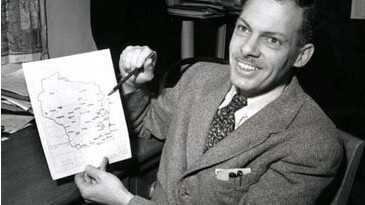Regional English Dictionary out of Madison is quite the whoopensocker

What do you say if a waiter asks if you want some dope with your sundae? Or if your buddy asks how the lawyers are biting this season? Is it a bubbler, or a drinking fountain, or a water fountain? What's the difference between a scramble, a covered-dish meal, a carry-in, and a potluck?
Thanks to the recently-completed Dictionary of American Regional English, or DARE, we can all know the answers to these questions.
Decades passed, and unfortunately so did Cassidy. But his death in 2000 did not damper DARE's progress. His epitaph encouraged his coworkers, saying "On to Z!"
The dictionary, started by UW - Madison professor Frederic Gomes Cassidy in 1963, is a five-volume collection of regional words used across the U.S. For five years, dozens of scholars and students combed the States interviewing a total of 2,777 Americans in over 1,000 communities. They conducted one of the longest surveys in modern history, with up to 1,800 questions covering 41 categories. The staff also scoured numerous books, newspapers, and diaries for common regional terms.

instigator of the Dictionary of American
Regional English, back in 1949.
After the interviews were completed, Cassidy and his crew began compiling the massive dictionary. Cassidy intended to finish the dictionary in a mere 13 years – in time for America's 1976 bicentennial – a very optimistic goal. Instead, the first volume, containing letters A through C, was released nine years after the initial deadline with a total of 1,059 pages.
Decades passed, and unfortunately so did Cassidy. But his death in 2000 did not damper DARE's progress. His epitaph encouraged his coworkers, saying "On to Z!" After nearly five decades of hard work, DARE has released the fifth volume, which concludes with “zydeco.” The five volumes combined contain over 60,000 entries.
There is still plenty of work for the DARE team. An online version is scheduled to debut in September of 2013. Additionally, a collection of regional maps is in the works, which will illustrate where people eat hoagies and where they eat subs. Other maps will show the language variations between young and old, rural and urban, and different races.
Peruse regional terms by state, try your luck at regional word quizzes, learn about the history of DARE, and check out their official website. You can purchase all five volumes of DARE from Harvard University Press.
Have an affinity for jargon? Check out this article about a local student's dictionary.




















